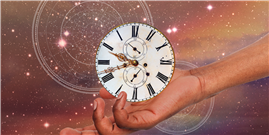So you’re an astrology newbie, but you want to get to the next level. Planetary aspects are v important because they are “the conversations” happening in the sky. Whether you’re consulting a handy-dandy birth chart (yours, your celebrity crush’s, your real-life crush’s, the potential new pal you met at the work mixer, etc.) or you just want to know what the current astrological weather is like, it’s crucial to take a peek at the planets for some insight into the overall MOOD.
So, what’s an aspect, exactly? First, some background: Astrology is the observation of the connections between the planets, the Sun, and the Moon from our perspective on Earth. Each planet (which in astrology includes the Sun and Moon, aka the “luminaries”) represents an energetic force within us, or a component of life. (To put it simply, Sun = ego, Moon = emotions, Mercury = mind/communication, Venus = love, Mars = sex, Jupiter = luck, Saturn = discipline, Uranus = change, Neptune = spirit, Pluto = transformation.)
When we’re looking at a 360-degree view of the sky, we divide the circle into 12 houses. 360 total degrees divided by 12 = 30 degrees in each house. Planets move through different houses and zodiac signs, and as they move, they send messages to each other when they link at certain mathematical angles. These angles are what we call planetary aspects. There are five common major aspects, created by dividing that 360-degree circle of the cosmos by 1, 2, 3, and 4.
Here’s a list of some of the major aspects and what they do to our lives.
Conjunction
When two planets are close to each other in the sky (within a couple of degrees, usually in the same zodiac sign), this means they form a conjunction and their energy is blended in unison. This can create a perfect alliance or bring intensity. In transiting astrology (“astro weather”), we can expect this day to be especially potent.
Conjunctions in transiting astrology mark new beginnings too: For instance, when the Sun and Moon form a conjunction, it creates a New Moon. If you have your Sun and Moon conjunct in your natal chart, it not only means you were born on a New Moon (or in some cases, a solar eclipse) but also that you will have an easy time synergizing your conscious and subconscious in the pursuit of your goals throughout your entire life.
Sextile
If two planets are separated by two zodiac signs and are roughly 60 degrees apart, we get one of the sweetest aspects of all—the sextile. Since these planets are in compatible elements two zodiac signs apart (earth + water or fire + air), they support one another and flow easily. Sextiles are often happy and chill, bringing good moods and camaraderie. An opportunity may present itself if we seize the day to take action and uncover it.
For instance, let’s say Venus and Neptune are sextile. If it’s taking place in your birth chart, you are blessed with creativity and a romantic demeanor. If the planets are linked in a sextile on a random day, we will be more openhearted at this time, likely pulled toward beauty, romance, or art. I’m getting butterflies just thinking about it!
Square
Yikes! One step further than a sextile is a square: Two planets are separated by three zodiac signs, meaning they are roughly 90 degrees apart. Get ready for a battle as each planet steps into the center of the ring to trade blows! When two planets are in a square, they share an astrological quality—they’re both cardinal, fixed, or mutable signs—but don’t have much else in common!
Squares often bring tension, struggles, and conflict, with each planet not seeing eye to eye. The best way to navigate this awk energy is to do your best to compromise. As an example, let’s say you have Mars square Saturn in your natal chart. Welp, that means you will often feel blocked and criticized by the world—especially around how you express yourself and pursue your passions. In transiting astrology, the days that Mars is square to Saturn will bring frustrations and obstacles to you as you’re pursuing your goals. Ick. However, challenges in astrology can also bring the greatest rewards, because they teach you to find your strength and create solutions.
Trine
Get ready for good vibes, bb! Next on our list is when two planets are four zodiac signs apart, or roughly 120 degrees. This aspect is called a trine, which means that the planets will be in the same element—fire, earth, air, or water. Trines bring luck, harmony, and opportunity. We can move forward easily, often with something presenting itself with very little effort.
Howevs, since trines are just ~so fab~, they can also make us lazy—as opposed to squares, which make us put in a ton of effort to get what we want. In a birth chart, let’s say Mercury and Uranus are in a trine—that means you’re blessed with a brilliant mind with a progressive view of the world. And if these two planets are frolicking through the heavens on a random day and meet in a trine, you can expect that exciting news is going to pop up for you suddenly, pushing you to form new ideas and open your mind.
Opposition
Whoa, tense much? These two planets are directly across the sky from each other and separated by six zodiac signs, meaning they’re about 180 degrees apart. (Quick guide to the opposites: Aries-Libra, Taurus-Scorpio, Gemini-Sagittarius, Cancer-Capricorn, Leo-Aquarius, and Virgo-Pisces.) On one hand, this can bring balance and union through compromise, almost like the planets fit together like two opposite puzzle pieces. But on the other hand, this aspect can bring obstacles. The planets will be in congenial elements (fire + air or earth + water), which on one hand can show that they can work together well when they try, but they also share an astrological quality (cardinal, fixed, or mutable), meaning they are pretty set in their ways and won’t really want to budge.
For example, let’s say you have the Sun opposite Pluto in your natal chart—like your Sun is in Taurus and your Pluto is in Scorpio. This means you’ll face many personal crises in life, likely around relationships, that will help to transform you repeatedly. In transiting astrology, the days that the Sun stands opposite Pluto will bring a major change, likely triggering a crisis moment that can help you evolve for the better.
Now, let’s talk about minor aspects
Yes, there’s more! Once you’ve mastered the more dynamic energies of major aspects, you can take a further dive into the energetic patterns of minor aspects. Minor aspects are less pronounced and more nuanced than major aspects, but can still bring a lot of insight into someone’s natal chart as well as the celestial vibes of day-to-day life. These aspects often affect us in a more nuanced emotional, mental, or spiritual way.
Inconjunct or quincunx
Uh oh, are you feeling that ~uneasy~ pressure? Could be an inconjunct aspect (which also goes by the fancy name of quincunx). This is considered the most important of the minor astrological aspects. An inconjunction occurs when two planets are separated by 150 degrees. This angle means they just can’t see eye-to-eye and make each other uncomfortable—ick! Inevitably, one planet’s energy is going to dominate the other’s.
The best way to work with this energy is to use self-reflection to find a way to better balance the two—even though it’s immensely hard to integrate both energies fluidly. I mean, can’t we all just get along? Another way of considering the inconjunct is to look at it as a time or situation where you need to adjust your tactics to reach your goal. Another important note to make is when two planets are inconjunct, they are different in modality, polarity, and element—basically, they share no common ground.
Quintile
Are you feeling those soft, subtle good vibes? Say hello to the quintile. This energetic flow is all about tapping into your heightened senses and talents—but it’s something you must take action toward to make happen. Quintiles occur when two planets are 72 degrees apart, which looks like a five-pointed star inside a circle. Often quintiles, give us boost our ambition, creating an area of opportunity to express yourself and create an impact. Quintiles also give us a special opportunity to look at things from a unique perspective in ways other people may not perceive.
Semi-sextile
Oh look, another shady aspect? The semi-sextile occurs when two planets link at 30 degrees, creating a sense of friction and unease. The energetic flow between them is attractive, as if they’re making each other curious, but requires effort in order to incorporate the other planet’s vibe and information. When two planets are semi-sextile, they are in neighboring zodiac signs. And by their very nature, zodiac signs that are before or after one are super different as they do not share a modality, element, or polarity. While the planets may feel alien to each other because they can’t really “see each other clearly,” there is something to be gained from semi-sextiles. Look at this as an opportunity to learn to work in tandem to realize the full potential of a situation. Remember, just because there’s the potential for understanding, it doesn’t guarantee it’ll happen—but it’s good to be aware so you can avoid miscommunication.
Semi-square
The semi-square is giving you a literal side-eye! This aspect takes place when two planets are linked at 45 degrees, in two adjacent signs or houses. Tension? Mm-hmm. The friction here isn’t as tough as it is a square and it’s certainly subtler, but it will still grind your nerves. Remain calm, balanced, and grounded to navigate this annoying energy. Be extra aware of how you responding to tension and conflict, so you can make proper choices to make things run as smoothly as they can.
Sesquiquadrate or sesquisquare
Yes, this aspect is impossible to spell. A sesquiquadrate occurs when two planets are 135 degrees apart; this is also sometimes called the sesquisquare. This aspect has cranky energy: Neither planet is interested in working together, which yet again brings some tension beneath the radar. The best way to deal with this vibe is to face it honestly and practice moderation and control, rather than giving into conflict. It’s best to work through this trash energy than just forever being stubborn.
Bi-quintile
Phew! We can have a breath of fresh air. The bi-quintile is double the quintile—or two fifths of a circle. This is a super subtle, chillaxed alignment. It occurs when two planets are separated by 144 degrees. This aspect gives you the opportunity to unearth important talents and creative abilities, but you have to work on this—not just sit back and wait for it to happen. The bi-quintile also gives you the chance to be original and inventive in finding constructive solutions to irksome problems. Think outside the box!
Septile
Then last—but not least—is the septile. This occurs when two planets are exactly 51 degrees and 25 minutes apart—and it’s a divine and spiritual aspect. A septile is formed by dividing a 360-degree circle (like a birth chart or horoscope) by the number 7. Seven has long been considered a divine number with spiritual implications, and because of this, the septile is seen as a sense of awe, wonder, and inspiration that allows us to awaken to a greater religious or artistic awareness. This vibe helps us see beyond just ourselves into how we may be able to use our talents or perception to experience energies that are so subtle, we are quite faintly tapping into a different dimension. Cool!
No matter what aspects we have in our charts or in the sky, they’re here to bring new experiences and help us to live balanced and transformative lives. Without them, we wouldn’t be who we are. So embrace them and plan ahead by using them. You’ve got the stars in you!
Source: Read Full Article



